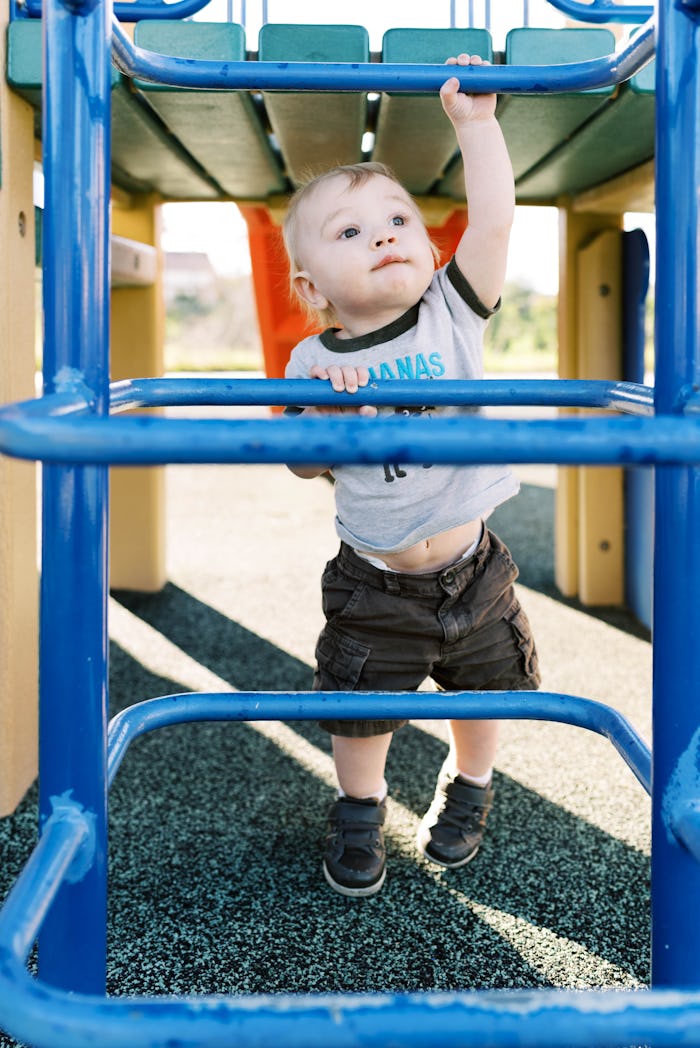Life

Here Are 7 Things Doctors Really Wish Parents Knew About Jungle Gyms
When it comes to working off some wild kid energy, jungle gyms are an easy sell. Who hasn’t turned the car in reverse on a busy afternoon errand run and said, “That’s it, we’re going to the playground!” I certainly have. But even if these monkey bar oases can be truly lifesaving at times, parents should know to never let down their guard. As medical practitioners will tell you, there are lots of important things doctors want you to know about jungle gyms.
All too often, caregivers think of playgrounds as safe, kid-friendly, supervised environments. That's according to Aynsley Birkner, the Pediatric Injury Prevention Coordinator and Safe Kids Charleston Area Coordinator at Medical University of South Carolina, who tells Romper that without the proper precautions, playgrounds can put kids at risk of injury... and jungle gyms are one of the most dangerous things on the playground. “According to the Consumer Product Safety Commission, emergency departments in the U.S. treat more than 200,000 children for playground-related injuries every year,” Birkner says. “Injuries resulting from falls are the most common and climbing equipment, such as monkey bars, accounts for the majority of injuries that occur on public playgrounds.”
Dr. William Melvin Brown, III, a board-certified emergency medicine physician in Charleston, South Carolina, agrees. "There is not a week that goes by that I don't see a playground injury," says Dr. Brown. The most common? Fractures from falling off the jungle gym. "A lot of the main issues are the surfaces kids are falling onto," Dr. Brown adds. In fact, his Emergency Room even has a shorthand for it: FOOSH = Fall On Outstretched Hand. So how can you prevent your own FOOSH nightmare?
Here’s what they say parents should keep in mind before letting their kids loose on the jungle gym.
1Check the playground surface
Avoid playgrounds with hard, non-impact absorbing surfaces such as asphalt, concrete, grass, dirt or gravel under jungle gyms. Birkner tells Romper that wood chips, sand, mulch, and shredded rubber (or rubber mats) are softer and shock-absorbing.
2Look for hazards
Inspect the chosen jungle gym and look for hazards such as rusted/broken areas or loose infrastructure. “Immediately report any hazards to the school or appropriate local office and do not allow children to use the equipment until it is safe,” says Birkner.
3Dress for play
Children should be appropriately dressed for swinging like a monkey; or in other words, without necklaces, scarves, or strings/straps that could get caught on equipment or pose a strangulation hazard.
4Set kids up for success
Always make sure the jungle gym is appropriate for your child’s age, size, abilities, and level of development. "The good news is playground equipment is getting better and better," says Dr. Brown. But it's still important to take a good look before releasing your child on to it.
5Supervision ≠ Scrolling
“Caregivers should actively supervise children at all times so that in the event of an emergency, they can respond immediately,” says Birkner. That means not spacing off into phone land. Sure, you can do a little scrolling, but ultimately you need to keep your eyes on your kids.
6Teach proper safety
“Lastly, teach kids the rules of the playground and reinforce safety messages,” says Birkner. You can empower children by being a good role model and demonstrating these behaviors as well. “This will help them to be cautious while playing, even in your absence,” Birkner says.
7Console before freaking out
"Remember, kids don't die from broken bones," says Dr. Brown. While it's easy to freak out upon seeing a fracture, Brown urges parents to take a deep breath and comfort a child first. "Be that caring parent, settle them down." That way when you get to urgent care or the hospital, they'll be reassured rather than in full panic mode.
Want more jungle gym best practices? Birkner encourages parents to check out playground guidelines from the National Program for Playground Safety. “They set the standard for safe play and equipment, as well as offer a playground maintenance technician certification. Individuals who complete this training are equipped with the knowledge to identify safety/legal issues and repair damaged equipment,” says Birkner. “Other pediatric organizations such as the CDC and National Safety Council have guidelines as well.”
Experts:
Aynsley Birkner, Pediatric Injury Prevention Coordinator and Safe Kids Charleston Area Coordinator at Medical University of South Carolina, musckids.org
Dr. William Melvin Brown, III, MD, Emergency Medicine Physician